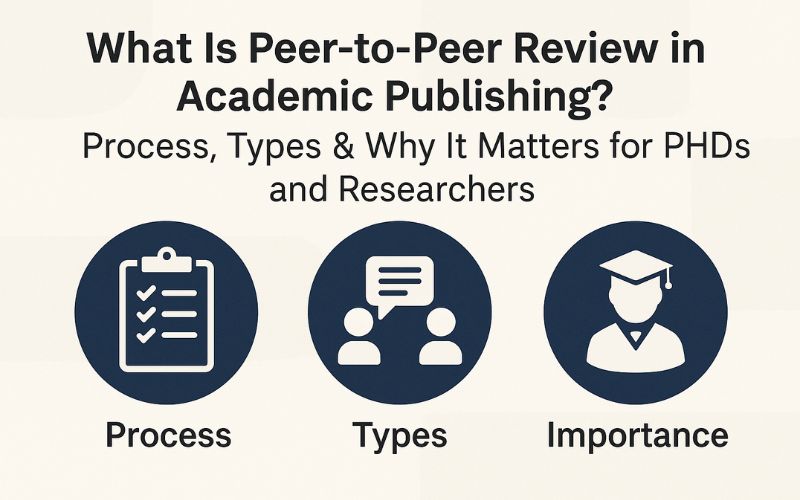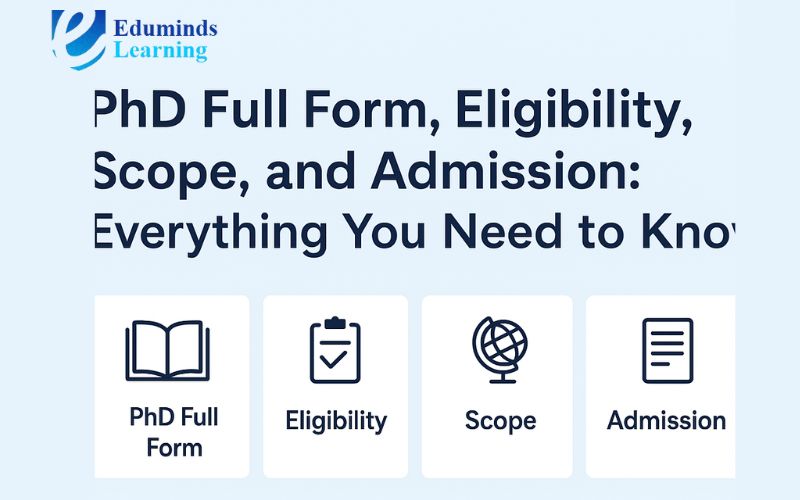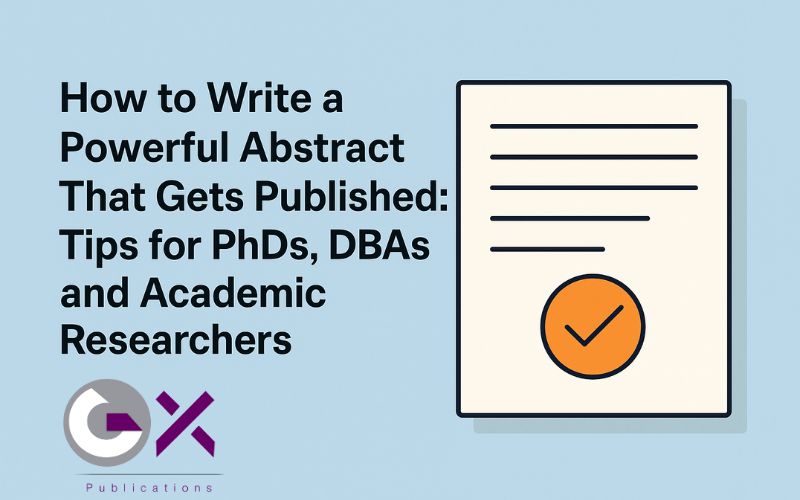What Is Peer-to-Peer Review in Academic Publishing? Process, Types & Why It Matters for PhDs and Res

Strong 8k brings an ultra-HD IPTV experience to your living room and your pocket.
When one is writing a thesis or research paper, it is necessary to ensure that the work is useful, honest, and clear. That is where peer-to-peer review is essential. It's a basic process where other professionals working in the same area review the research prior to publishing.
This helps find mistakes, improve the quality, and make sure the work is real and helpful. If you’re a PhD scholar, professor, or a postgraduate researcher, peer review helps your work get taken seriously by the academic world.
At GlobalX Publications, we guide scholars through this process. Whether you are submitting a peer-reviewed article or publishing a thesis, knowing how peer review operates is the beginning of making your work visible in respected academic journals.
In this blog, we will dissect what peer review entails, how it operates, various types, and why it is so central to academic publishing.
What Is Peer-to-Peer Review in Academic Publishing?
Peer-to-peer review is a method of inspecting research quality prior to publication. It implies other specialists—most likely in the same area—read your paper and provide comments. These individuals are not your team members. They are tasked with searching for mistakes, verifying facts, and ensuring the research is coherent.
This is a process used in academic publication, where researchers, PhDs, and lecturers would like their work to be published in journals. It ensures that good, fair research is the only kind shared with other people.
Here’s how it works in simple terms:
• You write and send your article or thesis to a journal.
• The journal asks experts to review your work.
• Reviewers give comments or ask for changes.
• You fix your work and send it back.
• If all looks good, the journal publishes it.
Peer review safeguards the integrity of research. It assists authors in refining their writing. It assists readers in trusting what they read as well.
If you are attempting to publish a scholarly paper or thesis, then you need to know peer review. It's a step that each serious researcher undertakes.
Why Peer Review Is Important in Academic Publishing
Peer review keeps research honest and transparent. It is a process in which, prior to publishing a paper, other professionals in the same field read and verify it.
It is not merely the process of locating errors. It makes the job improved. It indicates whether the research is logical, whether the facts are accurate, and whether the concept is helpful.
For researchers, professors, and PhDs, peer review establishes trust. It demonstrates that their writing is of good academic quality.
Here’s why peer review matters:
• It helps filter out weak or false claims.
• It gives helpful feedback to improve the paper.
• It makes research more trusted by readers and journals.
• It supports career growth by adding value to published work.
• It helps journals keep their quality high.
If you wish for your research to be taken seriously, peer review is something you cannot avoid. It safeguards your work and enables you to develop as a scholar.
How the Peer Review Process Works (Step-by-Step)
Peer review helps make sure that research is clear, honest, and useful. Here’s how it usually works:
• Step 1: Submission
The author sends their article or paper to a journal or publishing platform.
• Step 2: Editor Check
An editor looks at the work to see if it fits the journal and basic rules. If it does, they send it to reviewers.
• Step 3: Review by Experts
Experts in the same field read the work. They check if the research is correct, well-written, and original.
• Step 4: Feedback
Reviewers give comments. They might suggest changes or ask questions. Sometimes, they recommend rejecting or accepting the paper.
• Step 5: Revision
The author reads the feedback and makes changes. Then they send the updated version back.
• Step 6: Final Decision
The editor looks at the revised paper and makes a final call—accept, reject, or ask for more changes.
This process helps keep academic publishing fair and honest. It also improves the quality of work before it gets shared with the public.
Types of Peer Review Explained
When you send your research to a journal, it doesn’t get published right away. Experts first check your work. This step is called peer review. There are different ways this can happen. Each one has its own method for keeping things fair and honest.
Here are the main types:
• Single-Blind Review
The reviewer knows who wrote the paper, but the author doesn’t know who the reviewer is. This helps the reviewer be honest, but it can also lead to bias.
• Double-Blind Review
Neither the author nor the reviewer knows each other’s name. This is the most common type. It helps remove personal bias and keeps the focus on the research.
• Open Review
Both the author and the reviewer know who each other are. Sometimes, their comments are made public too. This is more transparent but can feel personal.
Each method has good and bad sides. The goal is always to check if the research is clear, original, and useful. Knowing these types helps you pick the right journal and prepare your work better.
Peer Review vs Editorial Review: What’s the Difference?
When you publish your research in an academic journal, it is typically subject to two reviews: editorial review and peer review. Both are essential but play distinct functions.
Editorial Review
Step one. The journal editor reviews your work to determine if it belongs to the journal's topic. They also review for simple problems such as spelling, grammar, and formatting. If the editor believes your work meets the simple guidelines, they pass it on.
Peer Review
This is the second and deeper step. Experts in your field read your work. They test the facts, the methods of research, and the findings of your work. They recommend changes or raise questions to ensure that your work is clear and honest.
Key Differences
• Editorial review checks style, clarity, and topic match.
• Peer review checks research quality, accuracy, and value.
• Editors are general reviewers.
• Peer reviewers are subject experts.
Both actions ensure your article is clear, reliable, and ready for use by others. If you are going to publish your research paper or thesis, understanding this process enables you to prepare more effectively.
Common Challenges Faced by Authors in Peer Review
Passing through peer review may be challenging, particularly for first-time authors. Even seasoned researchers have a couple of bumps. Following are some common problems they encounter:
• Long wait times
After submitting a paper, it can take weeks or even months to hear back. This delay can be stressful and slow down academic progress.
• Confusing or unclear feedback
Reviewers may give vague comments. Authors might not understand what changes are needed or how to fix things.
• Harsh or biased reviews
Sometimes, reviewers judge the work unfairly. Their feedback may feel personal or overly critical.
• Conflicting opinions
One reviewer may like the paper, while another may want major changes. This puts the author in a tough spot.
• Fear of rejection
Many authors worry about being rejected, even after working hard. This fear can stop them from sharing their research.
To overcome these challenges, remain calm, read the review properly, and revise with purpose. Seeking assistance from mentors or editors also ensures that the process is seamless.
Peer review isn't always easy, but it makes your work better and trusts academic publishing.
Tips for Researchers to Succeed in the Peer Review Process
Passing peer review can be a challenge, particularly when you are new to academic publishing. But with the following steps, you can make the experience easier and increase your chances of being published.
The following tips assist:
• Pick the right journal
Choose a journal that fits your topic. Look at what kinds of papers they accept and follow their style.
• Follow the rules
Every journal has its own format. Read the submission guidelines carefully and stick to them.
• Make your paper clear
Use simple language to explain your ideas. Reviewers appreciate papers that are easy to follow.
• Be honest and original
Share your own work. Don’t copy others. Use citations when needed.
• Respond politely to feedback
If reviewers ask for changes, make them. If you don’t agree, explain why clearly and calmly.
• Check your work
Edit your paper before sending it. Fix grammar, spelling, and structure. A clean paper shows care.
• Stay patient
Peer review takes time. Use that time to work on other ideas or improve your research.
Doing these things can help your work get noticed—and published.
Why Peer Review Matters More Than Ever Today
Research is growing fast. Every day, thousands of new papers are shared across the world. But not all of them are solid or trustworthy. This is where peer review helps.
Peer review is like a safety check. Before a paper is published, experts in the same field read it. They look for mistakes, missing proof, or unclear points. Their feedback helps authors fix problems before the work goes public.
Today, peer review matters because:
• It keeps fake or low-quality research out of journals.
• It helps authors improve their work.
• It builds trust among researchers, students, and readers.
• It supports fair and honest publishing.
Many people rely on published work to make big decisions. Doctors, teachers, students, and researchers all need clear and honest findings. Peer review protects that trust.
With the rise of online journals and global publishing, anyone can try to share research. But peer-reviewed work stands out. It shows the author took the time to check, revise, and meet standards.
For PhDs, professors, and early-career academics, peer review helps build a strong name in their field. It’s more than just a step — it’s part of good research.
How GlobalX Publications Supports Peer Review and Scholarly Publishing
GlobalX Publications helps researchers publish their work with confidence. The platform is built for PhDs, professors, and scholars who want their research to be seen and respected.
Here’s how GlobalX supports the peer review process:
• Guided Submission
Authors get clear steps to prepare and send their work for review.
• Peer Review Support
Every submission is checked by experts. Feedback helps improve the paper before it goes public.
• Help for New Researchers
First-time authors get help understanding what reviewers look for.
• Trusted Academic Journals
GlobalX connects writers with journals that follow strong review practices.
• Simple Process
No confusing steps. Authors can focus on their research instead of worrying about the review.
GlobalX makes publishing smoother for scholars at all levels. Whether it’s your first paper or your tenth, the goal is the same—clear, honest feedback and strong research shared with the world.
Conclusion
Peer-to-peer review is a large component of academic publishing. It assists in ensuring research is concise, authentic, and beneficial. When other people in your area of study review your work, they are able to identify errors, pose good questions, and assist you in making your paper stronger.
For PhDs, professors, and and early-career scientists, undergoing this review process instills trust in your work. It also assists in developing you as a writer and thinker.
If you plan on publishing your research or thesis, knowing how peer review functions will be an advantage. Being aware of the process and forms of review allows you to prepare sufficiently and respond with confidence.
Most leading journals adhere to peer review to maintain high quality. That is why your work must go through this process if you intend to publish in reputable academic journals.
Publishing with a solid platform such as GlobalX can help walk you through this process. It brings your work to the attention of expert reviewers and helps guide you through until publication.
Don't take peer review lightly. It's not a step — it's part of doing good, reliable scholarly work.
Note: IndiBlogHub features both user-submitted and editorial content. We do not verify third-party contributions. Read our Disclaimer and Privacy Policyfor details.







